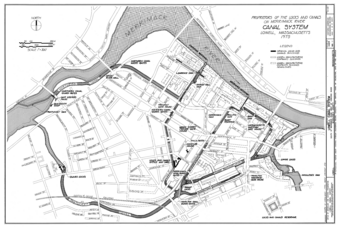Lowell Power Canal System and Pawtucket Gatehouse facts for kids
|
Lowell Locks and Canals Historic District
|
|

A 1975 map showing the canal system
|
|
| Location | Lowell, Massachusetts |
|---|---|
| Built | 1821 |
| Architect | Nathan Appleton, Kirk Boott |
| NRHP reference No. | 76001972 |
Quick facts for kids Significant dates |
|
| Added to NRHP | August 13, 1976 |
| Designated NHLD | December 22, 1977 |
The Lowell Power Canal System is the biggest power canal system in the United States. It stretches for about 5.6 miles (9 kilometers). This amazing system can create a lot of power, around 10,000 horsepower! It uses six main canals on two different levels, all controlled by many special gates.
This system started way back in the 1790s. It was first built as a way to move things, called the Pawtucket Canal. Its main job was to help logs from New Hampshire travel down the Merrimack River. The logs were going to places like Newburyport, Massachusetts to be used for shipbuilding. The canal helped boats and logs get around the big 30-foot drop at the Pawtucket Falls.
In the early 1820s, a group of business people bought the old Pawtucket Canal. They were called the Boston Associates. They bought it in a place that was then called East Chelmsford, Massachusetts. This group was connected to Francis Cabot Lowell, who had recently passed away.
Within a few years, this area became the industrial city of Lowell. The city began using the canals as a direct way to power their textile mills. They made the Pawtucket Canal wider and deeper. The first new canal they built was the Merrimack Canal. It powered the Merrimack Manufacturing Company. The company that owned the canals, called the Proprietors of Locks and Canals, could sell water power to other businesses. This started with the Hamilton Canal. This led to Lowell growing very quickly from a town into a big city.
Contents
How the Canal System Grew and Changed
By the late 1840s, the canal system in Lowell was making as much power as it possibly could. But a clever engineer named James B. Francis had an idea. He was the Chief Engineer for Locks and Canals. He designed two new parts: the Northern Canal and the Moody Street Feeder. These additions helped bring more water to different parts of the system. This made the whole system work even better.
The Pawtucket Gatehouse
The Pawtucket Gatehouse was built to control how much water flowed from behind the Pawtucket Dam into the Northern Canal. This building is very important for managing the water.
The dam itself was built about twenty years before the Gatehouse. It was made longer when the new canals were added. This dam can even send all the water from the Merrimack River (when the river flow is low) into the two main canal entrances above it. The dam is made of stone and has wooden "flashboard"s on top. These flashboards are still used today!
The flashboards and metal pins control the water level. If too much water goes over the dam, the pins bend. This releases the boards, and more water flows out of the dam.
Inside the Gatehouse
The Gatehouse has ten large wooden gates. These gates control how much water from the Merrimack River flows into the canal. When they were first built, a special machine called a Francis Turbine opened them. This turbine was also invented by James B. Francis.
Today, the Gatehouse gates are controlled by electricity and can be operated from far away. A company called Boott Hydroelectric manages them. This company is partly a continuation of the original Proprietors of Locks and Canals. They run a 24-megawatt hydroplant on the Northern Canal, which makes electricity from water power.
Recognizing the Canal System's Importance
The Lowell Canal System and the Pawtucket Gatehouse are very important historical sites. In 1984, the ASCE named them a Historic Civil Engineering Landmark. The next year, in 1985, the ASME called them a Historic Mechanical Engineering Landmark.
These sites are also part of the Lowell National Historical Park. The canal system was added to the National Register of Historic Places in 1976. The very next year, it was named a National Historic Landmark.
Timeline of Important Canals
- 1796: Pawtucket Canal
- 1822: Merrimack Canal
- 1825: Hamilton Canal
- 1828: Lowell Canal
- 1831: Lawrence Canal, Western Canal
- 1835: Eastern Canal
- 1847: Northern Canal, Moody Street Feeder, and Pawtucket Gatehouse
Images for kids




